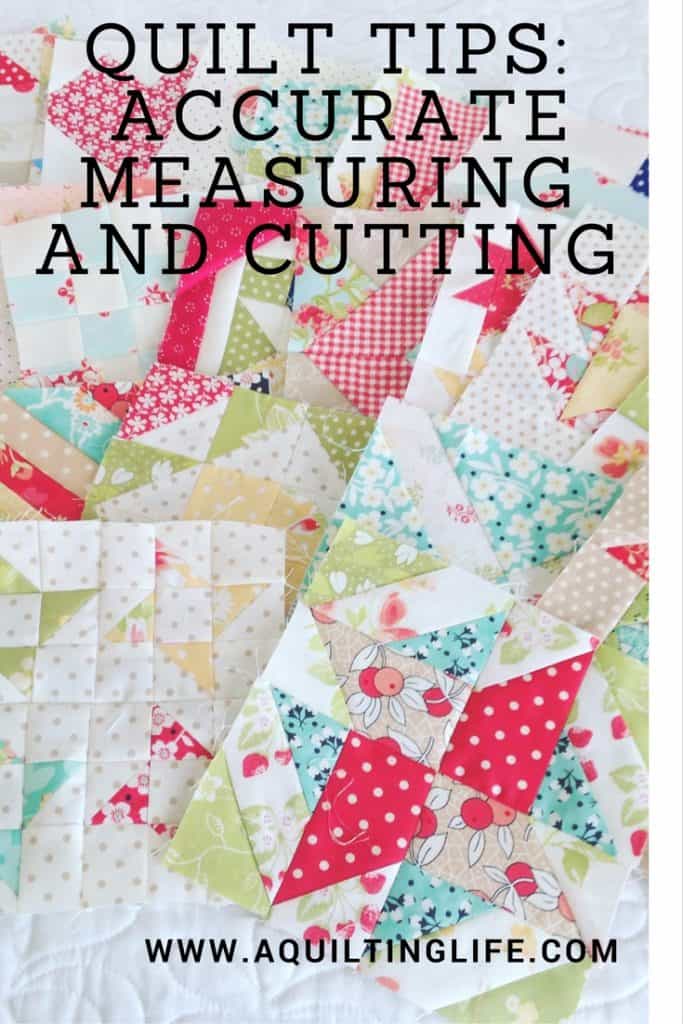Hello and happy Wednesday! Today I’d like to discuss a few tips and ideas to help with accurate measuring and cutting fabrics for quilting. The tips I’m sharing are ideas that have proven to be valuable insights to the quilters I get to work with when I teach quilting classes. It’s amazing how often one simple tip can really improve accuracy.
Of course, the most familiar of these tips is the oft-repeated “measure twice;
cut once” refrain that I first learned from my grandmother. But I also have some other ideas that will help get your measuring and cutting fabrics right on track!
Press fabrics before measuring and cutting.
Whether you are using scraps, yardage or pre-cuts (fat quarters, fat eighths, Layer Cakes, charm squares, or mini charm squares), it’s really important to press your fabrics before working with them. Many fabrics have folds or wrinkles in them which can affect the accuracy of your cutting, and many fabrics will shrink just a little bit the first time they are ironed. Whether you pre-wash fabrics or not, pressing before beginning to cut the fabrics can really affect the accuracy of your cut pieces.
Consider starching fabrics, especially when working with small pieces.
A lot of quilters starch all of their fabrics before beginning any project. I generally don’t use starch if I’m working with simple piecing; however, if I’m working on a project that requires precision piecing or if I’m making a mini quilt I starch and then iron my fabrics before beginning. Applying starch to fabric makes the fabric more stiff and helps prevent stretching and fraying. Pre-treating fabrics with starch can also help if you will be working with a lot of bias edges.
Use your cutting mat to line up edges of your fabric, not to measure it.
This tip is an important one. While the lines on cutting mats can be very helpful in lining up fabric and making sure it is straight, you will get more accurate cuts by using the lines on your ruler to measure.
Straighten fabric edges before beginning to cut.
Always trim fabric edges so they are even before beginning to cut. If you are cutting a lot of strips or pieces from a piece of fabric you’ll also want to periodically check to see if your fabric is still straight. I often have to trim ⅛″ to ¼″ after several cuts to make sure my fabric is still straight.
Use painter’s tape or washi tape on your ruler when making several cuts the same measurement.
This tip is especially helpful if you are having trouble remembering which line you are supposed to be using as your cutting guide or if you are cutting a piece with an⅛″ increment that is especially hard to find or see.
Use a sharp rotary blade for cutting your fabrics.
Simply put: sharp rotary blades cut more accurately. I’ve noticed while teaching that a lot of cutting errors students make are caused because they are using dull blades. Rotary blades are expensive, and it’s not fun to have to purchase them; however, using a sharp blade can really make a difference in how easily and accurately you are able to cut your fabrics.
Use a rotating cutting mat whenever possible rather than cutting towards your body.
It’s easier to be accurate with cutting when cutting away from your body. When making multiple cuts that require different directions, you can increase accuracy by using a rotating cutting mat. The rotating mat doesn’t need to be very large–I use an OLFA 12″ Rotating Self-Healing Rotary Mat that I keep on a shelf and put on top of my larger cutting mat when I need it.
Measure twice; cut once.
Yes, I had to repeat this tip. It was the first thing my grandmother told me when she gave me my first quilting lesson, and many of my mistakes have come because I didn’t always heed this rule! Funny story: I mentioned this to my husband once, and he was surprised to find that a rule he uses in a lot of his hobbies can also be applied to quilting!
Make sure you have an accurate ¼″ seam allowance
Finally…make sure you are sewing with an accurate ¼″ seam allowance. You can watch the video above to double check your accuracy.
I hope some of these tips will help you achieve greater accuracy when measuring and cutting your quilting fabrics. If you have any additional tips or ideas on this topic, I’d love to hear them in the comments section!
Thanks so much for stopping by!






Grandma says
Thank you, some I knew but never hurts to be reminded. As a fairly new quilter need the reminders
JenniferO says
Do you have suggestions on how to starch? I've seen tips like that before – use starch with small pieces, pieces cut on the bias, but no on ever says how to starch. It's not something I've ever used before and the directions on the bottle are directed more toward starching clothes.
mascanlon says
I always use my big box store coupon for rotary blades and then I am not so reluctant about a switching out. ( but never any fabric there…lol)
Hildy says
Great tips thanks for sharing!
Karen Dobbs says
I do love Best Press for starching. I always press my fabrics with Best Press before beginning a project.
Stacy says
Excellent tips. I recently learned about using my ruler instead of mat lines to cut fabric and it was a huge game changer in my accuracy. Thanks for all the great posts you do!
Joan says
Thank you for the great tips. i always look forward to your posts.
Judy says
Thank you! I will use more starch before I press. I have to figure out how to sew those hst edges together. My Bernina isn't very good with that.
Rosemary B❤️ says
Sherri, this is all very good advice and great reminders. We should etch these tips in our brains!
Yes, even sometimes measuring twice…. well, it happens
Julie Cefalu says
Great tips, Sherri! I especially agree with NOT using the cutting mat to measure with and I love it when I starch my fabric before I do any cutting. Julie@TheCraftyQuilter.com
Carol Jordan says
I think this was a great article. So many quilters novice and experienced do not take the time to get everything set up just right before they cut into their $14.00 a yard fabric!
Gmama Jane says
I've done all of these BUT use my ruler for measuring and my mat for lining up rather than measuring. That may just be my problem! never never heard this rule and I've quilting quilting for 15 yrs but have complained about my accuracy in piecing. Thank you very much! Never I assume we know something. Like me, I've been using my mat for measuring most of the time!